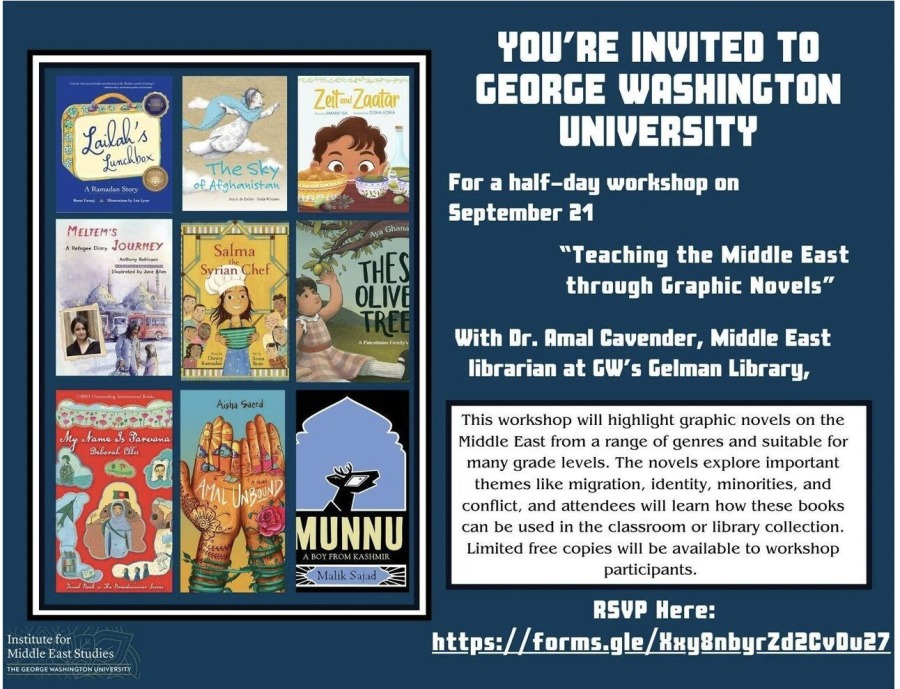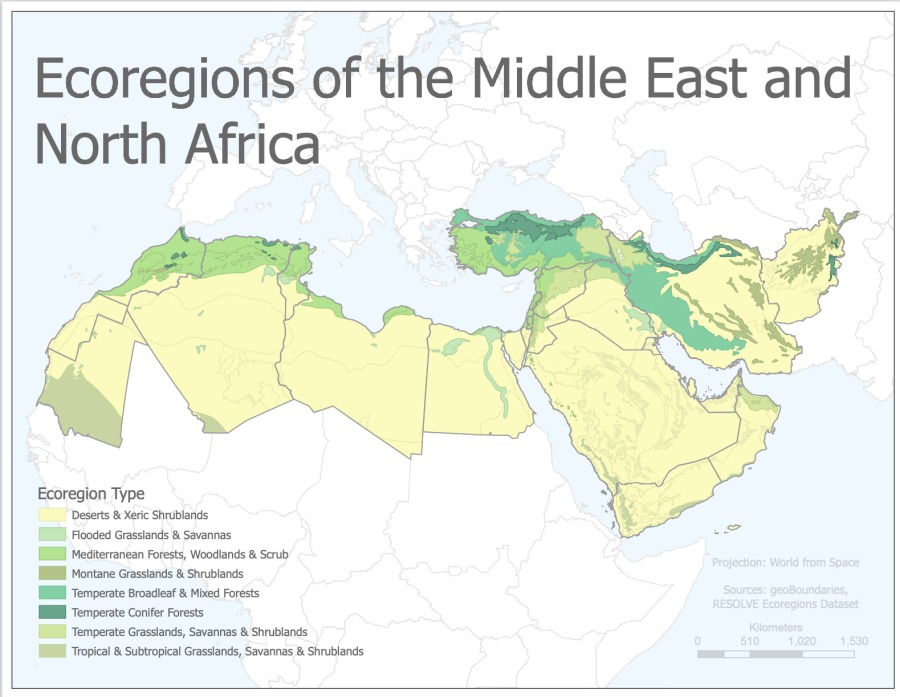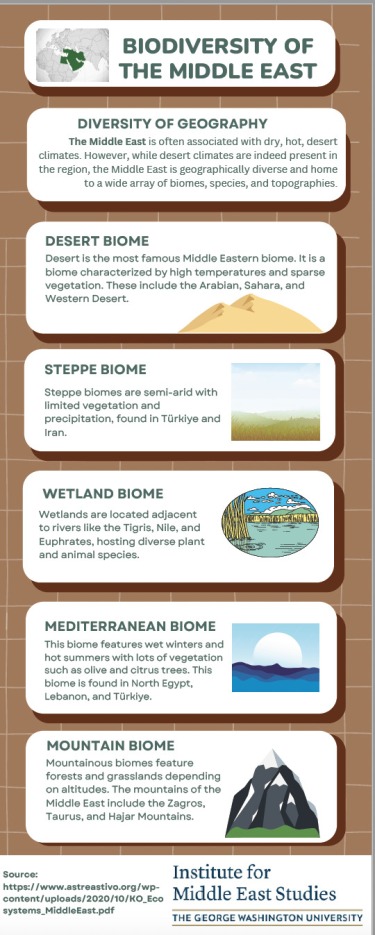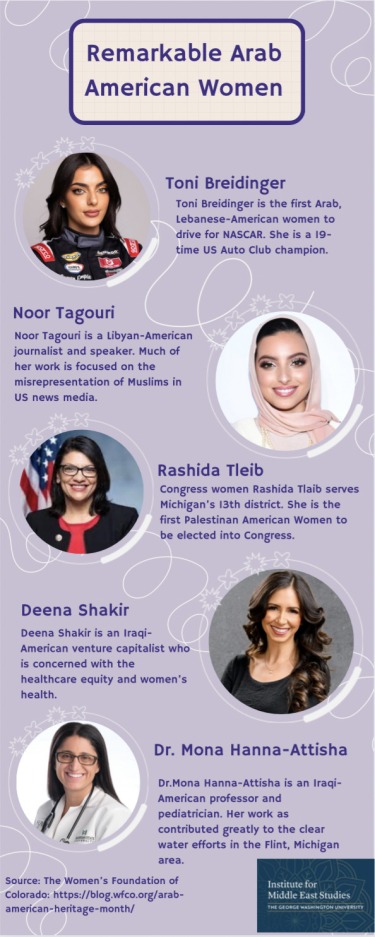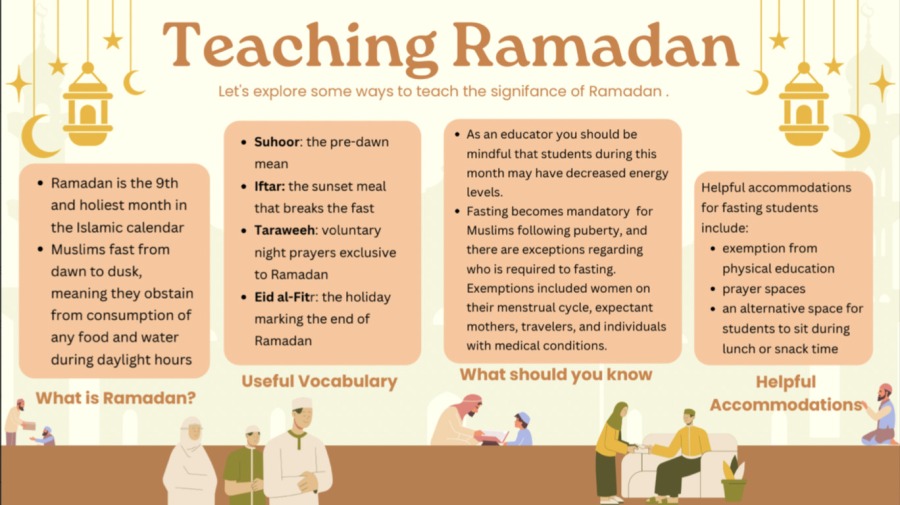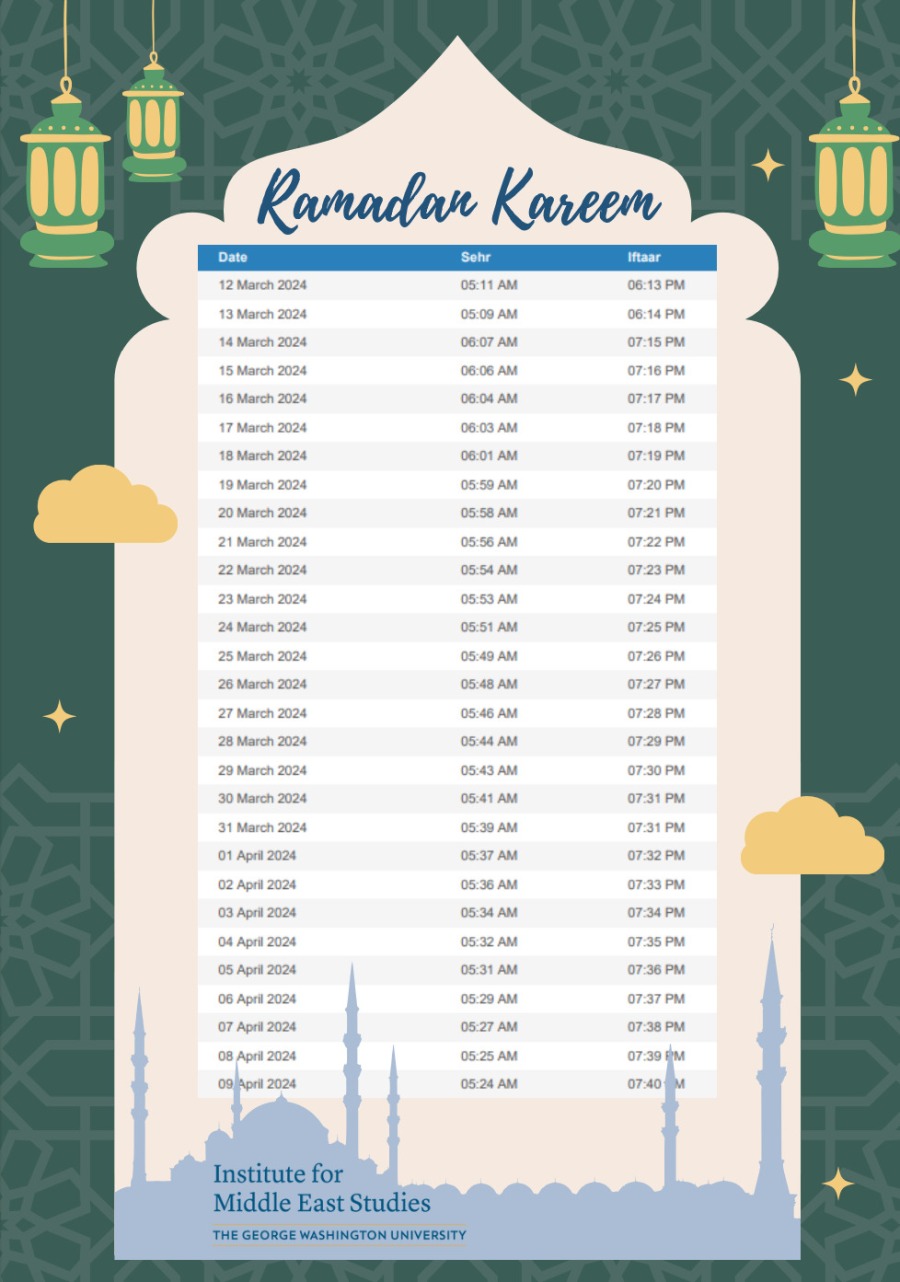Thematic Teacher Resource Roundup
Using Graphic Novels to Teach About the Middle East
Graphic novels can be powerful educational tools, offering a unique blend of visual art and narrative that provides an accessible entry point for discussing complex subjects. By incorporating graphic novels into the curriculum, educators can leverage students’ creativity to explore diverse cultures, historical events, and personal stories.
Join us on September 21st for an in-person workshop on teaching with graphic novels featuring GW’s Middle East Research Librarian, Amal Cavender. The workshop will highlight graphic novels on the Middle East across a range of genres and grade levels. The books explore important themes like migration, identity, minorities, and conflict and the workshop will examine how they can be used in the classroom or library.
GW’s Gelman Library has a resource guide that catalogs many graphic novels, political posters, and other art forms useful in teaching on the Middle East. The below list is a short sample of the range of graphic novels and lesson plans suitable for K-12 classrooms – many of which already have teaching and discussion guides and related classroom material. The September 21st workshop will feature these and many other graphic novel resources, provide attendees with the opportunity to examine hard copies of the materials, and explore ways they can be used in instruction and class activities.
Featured Graphic Novels
Persepolis by Marjane Satrapi
Persepolis is an award winning graphic novel that portrays childhood and early adulthood in Iran during and after the Islamic Revolution, Through striking black and white illustrations the novel explores themes of rebellion, identity, and political upheaval. Use this Persepolis teaching guide in your classroom.
Meltem’s Journey: A Refugee Diary by Anthony Robinson
This graphic novel follows a young girl from Syria, Meltem, as she embarks on the difficult journey to find safety. This is a child-friendly story that portrays the refugee struggle while presenting themes of perseverance and hope. Try an interactive story map, cultural reflection activity, and lesson plans based on Meltem’s Journey in your classroom!
Thunder over Kandahar by Sharon McKay
This story explores the themes of friendship and bravery through the lives of two girls from Afghanistan trying to navigate their new reality under the Taliban. It details their lives under war, threats, and constant danger. Use this lesson plan to explore this story with your students.
Welcome to the New World by Jake Halpern & Michael Sloan
Welcome to the New World follows Ibrahim and his family on their journey from Syria to the United States as he navigates and adjusts to his new reality.. Check out this article in The Geography Teacher magazine and curriculum/handouts based on the novel from The Immigrant Learning Center.
Additional Resources
- Teaching Guide on refugees, including activities and lesson plans around graphic novels from The Catholic Alliance for People Seeking Asylum.
- GW’s Graphic Novel Collection at the Gelman Library Global Resource Center
- IMES Resources for teaching Persepolis and Persepolis 2
- TED Talk: Comics belong in the classroom
- University of Michigan – The Middle East Through Graphic Novels Article
On Earth Day, let us appreciate the diverse landscape of the Middle East. Although often associated with desert terrain, the region boasts rich biodiversity, with the rugged Al Hajar Mountains of Oman, the vibrant coastal Mediterranean, the semi-arid steppe biomes found in Türkiye in Iran, and the diverse wetlands adjacent to the Tigris and Euphrates.
Climate change poses a significant threat to the biodiversity of the Middle East. Rising temperatures, inconsistent rainfall, and extreme weather events are altering habitats and disrupting ecosystems. The variety of life forms in the region now face the challenge of rapidly evolving environmental conditions, jeopardizing their survival and ecological balance.
One of the major challenges currently facing the Middle East is water access. Water scarcity, particularly freshwater, is an ever-increasing concern as many Arab countries suffer from a lack of rainfall and prolonged droughts. Access to clean and sustainable water sources is crucial for both human populations and the diverse ecosystems that rely on them.
Review the resources below to learn more about the biodiversity and environmental challenges in the Middle East:
- For an AP level overview about Middle Eastern and North Africa geography, natural resources, and climate, use this excellent video Physical Geography of the Middle East and North Africa, or this video that demonstrates the diversity of Middle Eastern Geography.
- To learn more about the pressing climate change issues present in the Middle East, use this overview video from the Middle East Institute Climate Change in the Middle East and review this article from the Brookings Institute, Climate change may devastate the Middle East. Here’s how governments should tackle it, that offers suggestions for climate change policy recommendations.
- This article from Nature Middle East explains how climate change is exacerbating loss of biodiversity in the Middle East.
- This article from Green Peace clearly explains biodiversity in the Arab world based on country.
- To learn more about the desalination process of the United Arab Emirates as a method of addressing the Middle Eastern water security concerns, watch this information video Could the Middle East run out of water? How one country gets around the problem.
- For another specific example of Middle East governments attempt to mitigate climate change, this interesting article by Condé Nast Traveler explores the Saudi Arabian effort to restore biodiversity through tourism.
- Explore environmental activism and pressing issues in North Africa using IMES-IMPOP multimedia web pages. These web-pages feature video interviews with experts in the field, political cartoons, infographics, maps, image slideshows, an article, and additional classroom resources.
- Egyptians Unite to Halt Multinational Fertilizer Plant that Threatens Fishing and Tourism
- Environmental Exploitation Triggers Protests Across Algeria – Institute for Middle East Studies
- Moroccan Farmers Compete with Solar Complexes for Access to Dwindling Water Resources – Institute for Middle East Studies
- Marginalized Tunisians Organize to Demand Economic and Social Change – Institute for Middle East Studies
On March 31st, 2023, President Joe Biden issued a proclamation declaring the month of April as Arab American Heritage Month. As the proclamation states, “the Arab American story is the American story”, one that includes diverse backgrounds and faiths and rich traditions and culture. This month we encourage you to recognize and celebrate the achievements and contributions of Arab Americans in shaping the United States through their unique heritages, customs, and talents.
During this special month for the Arab American community, the United States Census announced it will officially recognize Middle Eastern and North African as a category on the national census. It is estimated that 8 million Americans identity as Arab American, and this historic decision is significant as it promotes Arab representation and validates diverse Arab identities. The Census Bureau released this statement announcing the proclamation along with interesting statistics about Arab American demographics.
Check out the resources below for more information on how to celebrate Arab American Heritage Month in your classroom:
Arab American Heritage Foundation: “The Arab America Foundation (AAF) is a non-profit educational and cultural organization. AAF’s mission is to promote Arab heritage, educate Americans about the Arab identity, and to empower and connect Arab Americans with each other and with diverse organizations across the US. Learn more about Arab culture and presence in the US on the AAF website and make sure to check out their educational resources.
Arab American National Museum: Take a look at the Arab American National Museum to learn more about art and the history of the culture. Educational content for teachers can also be found on this site.
About Arab American Heritage Month: This resource provides a brief overview of Arab American Heritage month along with a series of resources that might be helpful when learning about Arab culture in the US.
More Teaching Resources:
Check out the National Endowment for the Humanities Virtual Bookshelf for Arab American Heritage Month.
In addition to Arab American Heritage Month, April is also National Poetry Month! Learn more about classic and contemporary Arab American poets like Khalil Gibran, and read some of their work, with resources from the Academy of American Poets.
Learning for Justice has collected resources for Arab American Heritage Month which celebrate Arab identity, counter negative stereotypes, teach about Arab history and cultures, and ensure an inclusive environment that supports Arab American students this month and throughout the year.
Invite an Expert:
Use our Zoom in on the Middle East Speaker’s Bureau to invite an 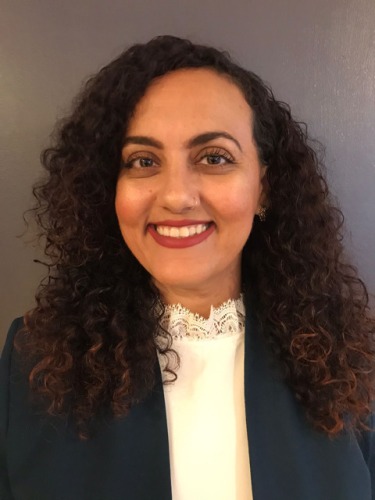 expert in the Middle East to speak to your classroom. Dr. Maro Youssef, was recently recognized on the Arab American Foundation’s 40 under 40. Invite her to speak on topics of United States foreign policy, gender, and feminist coalitions.
expert in the Middle East to speak to your classroom. Dr. Maro Youssef, was recently recognized on the Arab American Foundation’s 40 under 40. Invite her to speak on topics of United States foreign policy, gender, and feminist coalitions.
The role of women in politics and leadership in the Middle East has been evolving over time, with progress and challenges intertwined. Traditionally, the region has been characterized by patriarchal societal structures and cultural norms that have limited women’s participation in political and leadership roles.
In recent years, however, there have been notable changes and advancements. Some countries in the Middle East have made efforts to promote gender equality and increase women’s participation in politics. For example, several countries have implemented quotas to ensure a minimum representation of women in legislative bodies. This has led to an increase in the number of women holding parliamentary seats in countries like Iraq, Jordan, and the United Arab Emirates.
Women in the Middle East have also played significant roles in civil society and activism, advocating for social and political change. They have been at the forefront of movements pushing for women’s rights, legal reforms, and greater political representation.
Despite these positive developments, challenges persist. Cultural and traditional barriers, discriminatory laws, and gender stereotypes continue to hinder women’s full participation in politics and leadership. Additionally, progress has been uneven across the region, with some countries making more strides than others.
It’s essential to recognize the diversity within the Middle East, as each country has its own unique socio-cultural and political context. While some nations have made considerable progress, others still face significant barriers to women’s political empowerment.
In recent years, women’s participation in government has greatly increased in many Middle Eastern states. Currently, the percentage of women in government in Tunisia is 26%, 28.9% in Iraq, and has reached 50% in the United Arab Emirates.
In summary, the role of women in politics and leadership in the Middle East is complex and dynamic. There have been advancements, but there is still work to be done to achieve full gender equality and break down the remaining barriers that limit women’s participation in these spheres.
Teaching Resources:
- For background information about The Status of Women’s Eights in the Middle East, check out this article.
- This article details the legal barriers women in the Middle East and North Africa face.
- This document focuses on pressing women’s rights issues in the Islamic Republic of Iran.
- Use this article to teach about history’s seven of the most influential women from the Arab world.
- To learn about women’s participation in government across the Middle East and North Africa use this article.
- This video from the Wilson Center in collaboration with Merissa Khurma explains the changing political and social environment of the Middle East for women.
- PBS has developed a 90 minute lesson plan focused on Muslim women through time.
- This teaching guide from the Duke-UNC Consortium for Middle East Studies focuses on Women in the Middle East and the diversity of women’s experience in the MENA region.
- This comprehensive lesson plan from Teach Middle East features teaching guides, books, videos, and discussion topics.
- A recording of our IMES event Gendered Fortunes: Divination, Precarity, and Affect in Postsecular Turkey with Dr. Zeynep Korkman and Dr. Attiya Ahmad can be found on our website.
Black History Month presents an opportunity to reflect on our understanding of the history of slavery and racism in the Middle East. The practice of slavery in the Middle East dates back centuries, but for most of that time it remained limited in scale and lacked the racialized aspect that dominated the trans-Atlantic slave trade. As the historian George La Rue explains “Slaves were captured directly or purchased. In wars and raids, Middle Eastern armies captured enemy combatants and civilians to ransom or enslave. The mix of enslaved and servile persons brought into the region varied in its composition, reflecting the geographical areas of military actions, the development of powerful trading partners, and the extent of trading networks. Foreign merchants imported additional slaves from the Balkans, the Black Sea region, the islands and shores of the Mediterranean, Central Asia, and Africa—including the West African savanna, the Lake Chad region, Sudan, Ethiopia, and the Horn of Africa, particularly via the Swahili coast. These practices brought new servile populations as workers, domestic staff, concubines, soldiers, or bureaucrats to serve in imperial outposts, trading towns, or centers of agricultural, handicraft, or industrial production.”
The journalist Monir Ghaedi’s excellent primer on the history of slavery in the region tells us “This changed in the second half of the 19th century, when the booming global demand for the region’s date fruit and natural pearls created the urgent need for a workforce. Arab traders began increasingly kidnapping people from northeastern parts of the African continent and selling them in slave markets in the Gulf. Following the global recession of the 1930s, the pearl and date markets collapsed. Many slaves who worked in palm plantations or the pearl industry were freed by owners who could no longer afford to sustain them, according to Hopper. But it took a few decades until all Arab states of the Gulf region officially banned owning and trading slaves. Iraq had already formally abolished slavery in the early 1920s, and countries like Qatar and Saudi Arabia followed suit in 1952 and 1962, respectively. Oman, once one of the biggest slave markets in the region, was also one of the last. It outlawed the practice in 1970.”
In the contemporary landscape, the Middle East has seen a surge in popular anti-racism and decolonial movements, including many expressing solidarity with the Black Lives Matter protests in the US. Protests advocating for the rights of black communities resonated in Palestine, Tunisia, Syria, and beyond. Despite these efforts, conditions of modern-day slavery persist in the Middle East just as they persist throughout the world, often in the form of coerced domestic labor.
Explore the following resources to learn more about this topic:
Upcoming IMES Events:
March 20th – At this upcoming event at Howard University, in partnership IMES, Nadia Alhamed will present about the history of Black and Palestinian solidarity.
Video Resources
NCGE Webinar – Graham Cornwell | Geography and Identify in the 2022 World Cup: A Webinar discussing ethnic and racial identity in North Africa Sports.
For more resources relating to this topic, click here.
Opportunities for K-12 teachers:
The International and Foreign Language Education team at the U.S. Department of Education is excited to announce the launch of the FY 2024 Fulbright-Hays Group Projects Abroad competition.
The Group Projects Abroad (GPA) program provides grants to support overseas projects in training, research, and curriculum development in modern foreign languages and area studies for teachers, students, and faculty engaged in a common endeavor. Projects may include short-term seminars, curriculum development, group research or study, or advanced intensive language programs. The deadline is March 18, 2024.
The Notice Inviting Applicants published in the Federal Register on January 18th, 2024 can be found at:
Further Information on the application and the types of group projects can be found at this website: https://www2.ed.gov/programs/iegpsgpa/index.html.
The application package and instructions can be found at:
https://www.grants.gov/search-results-detail/351704
Please feel free to share this with any colleagues that might find this of interest, ahead of our March 18th deadline. Any questions regarding the program or application process can be directed to GPA@ed.gov.
The Institute for Middle East Studies at the George Washington University, partnership with the Middle East Research & Information Project, is delighted to present new multimedia content about refugees in Jordan, migrant labor laws in Jordan, and differential refugee aid. This piece is a part of the ongoing series that analyzes current issues in political economy, activism, and societies across the Arab world.
IMPOP is excited to announce our newest article, Discriminatory development aid – a look at the Jordan Syria Refugee Response, written by Shaddin Almasri, PhD of Migration candidate at Danube University Krems. This article is enhanced with multimedia pieces including an interview with Country Director of the International Refugee Assistance Project Kurt Bonz, an infographic, map, political cartoon, photojournalism, and a recommended reading list.
This feature piece discusses discriminatory aid in Jordan and the struggle for non-Syrian refugees to obtain employment in Jordan. It explored the Jordan response plan and refugee laws in the country, as well as other aid and assistance programs from migrants.
Check out the new IMPOP page here!
The ongoing conflict in the Middle East between Israel and Palestine is multifaceted and characterized by deep historical complexities. Recent events have heightened attention to this issue. In light of these ongoing developments, educators face the challenge of navigating this topic. Addressing this issue
requires access to balanced, accurate, and insightful resources. Given the emotional resonance of this conflict, having access to reliable resources becomes crucial in effectively conveying the history and politics of this crisis.
Invite GWU Associate Professor of Media and Public Affairs, Imani M. Cheers, to speak to your class about multimedia production, media literacy, or international field reporting, through the IMES Middle East Virtual Speakers Bureau. Access Professor Cheer’s documentaries “Agricultural Apartheid: Land and Water” and “Journey to Freedom.”
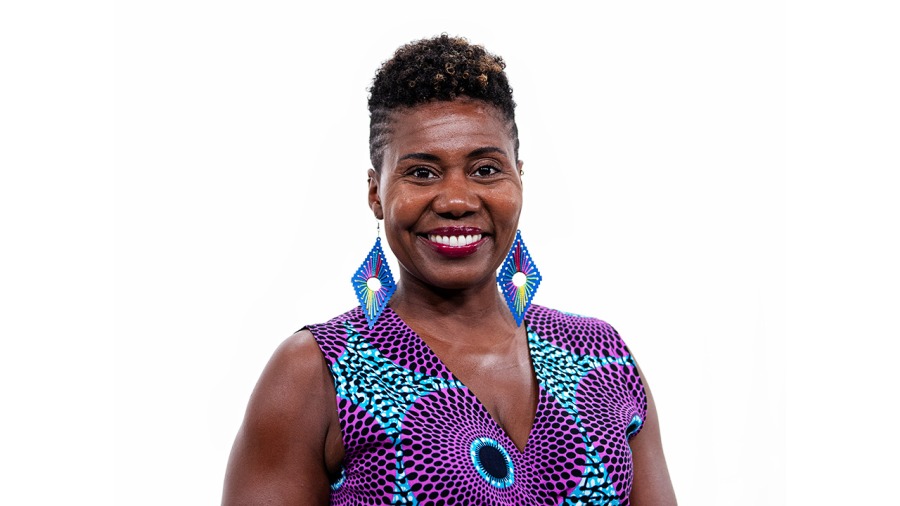
To support educators, IMES has compiled a list of English-language materials and resources to contextualize current events in Palestine.
- Palestine in Context Project: A series of ongoing webinars developed by an international consortium of university-level Middle East Studies programs providing history and context to the 2023 Israel-Palestine conflict.
- The Guardian (UK based news outlet): A Complete Guide to the 2023 Israel-Palestine Crisis.
- Zinn Education Foundation, a resource page of fact sheets, essays, film clips, podcasts, calls to action and other resources on Israel-Palestine, updated for November 2023.
- Middle East Research and Information Project (MERIP): Primer on Israel-Palestine Conflict.
- Visualizing Palestine (a project developed by ‘Visualizing Impact’ group): Infographics and visual tools illustrating what life is like in Palestine.
- Foundation for Middle East Peace (news, opinions, studies, surveys); updated empirical information and ongoing news analysis.
- Institute for Middle East Studies: Dismantling Myths on Israel-Palestine – Recording of a panel discussion on myths surrounding the Palestine-Israel conflict (from 2021).
- Origins of Zionism and the Palestine-Israel conflict by GW Professor Shira Robinson.
- Palestine in Context Project: Teaching guides related to the Gaza in Context film: (Film Teaching Guides)
- Resource Kits compiled by Javier Davila, Teacher and Student Equity Program Advisor with the Toronto
- District School Board (from 2021) (PDFs here):
September 11th, 2023 marks the 22nd anniversary of the 2001 terrorist attack on the World Trade Center and the Pentagon. The 9/11 terrorist attacks had profound global repercussions, leading to increased security measures, the initiation of the War on Terror, and a reshaping of international relations, as well as inspiring changes in policies and attitudes towards immigration, civil liberties, and surveillance. As today’s youth have been born and raised in a post-9/11 world, it remains important to educate and discuss the far-reaching impact of these events.
We encourage you to review the many educational resources available from the 9/11 Memorial and Museum including their 9/11 Anniversary Digital Learning Experience, lesson plans, and many digital resources.
One of the largest impacts seen after 9/11 was the rise of Islamophobia, or the fear, hatred, and prejudice against Islam and Muslims. Media depictions of negative Muslims stereotypes fed the perception that Islam and terrorism were intrinsically linked. These assumptions are rooted in a concept known as Orientalism, a framework that promotes an image of the Middle East and its people as primitive, irrational, and inferior. For more information and teaching resources on Orientalism and Islamophobia, check out our IMES Resource guide on Orientalism and Islamophobia.

Other IMES teaching resources for talking about 9/11 and its legacy include:
- Podcast on Islam in America by Nadia Marzouki. Marzouki explores how the topic of Islam has become so contentious in America. Marzouki says that controversies around Muslims living in America don’t just express Islamophobia, but “betray and express a deeper discomfort and unease with an understanding of law, an understanding of rights, and an understanding of equal democracy”.
- GW faculty member Elizabeth Anker discusses the Cultural, Strategic, and Political Impacts of 9/11 on its 20th anniversary.
- GWU’s Melani McAlister is a cultural historian who has written extensively about the U.S. Image of the Middle East and the interaction of culture and foreign policy. Invite Prof. McAlister to speak to your classes about how the war in Iraq shaped U.S. culture and media through the IMES Middle East Virtual Speakers Bureau.
The Six-Day War was a brief conflict fought between Israel and its neighboring Arab states of Egypt, Jordan, and Syria between June 5-10, 1967. The war lasted for six days, during which Israel emerged victorious and gained control of territories including the West Bank, Gaza Strip, Sinai Peninsula, and Golan Heights. Despite its brief length, the conflict is of immense political significance. The war had long-lasting consequences for the Middle East, including the displacement of hundreds of thousands of Palestinians and ongoing political and military tensions in the region. This event is essential to understanding the ongoing Israel-Palestine conflict. Use the resources below to learn more about this significant historical event:
Salt Houses is a novel by Hala Alyan that tells the story of a
Palestinian family spanning several generations, from the
aftermath of the Six-Day War in 1967 to the present day. The
novel explores themes of identity, displacement, and the search
for belonging, as the family members navigate the challenges of
living in different countries and cultures. Through vividly drawn
characters and settings, the book sheds light on the complexities
of Palestinian history and culture, while also touching on
universal themes of love, loss, and resilience. A reading guide for
Salt Houses can be found in the teacher resources section of the
IMES website. 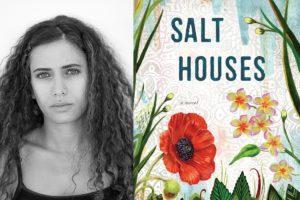
- This publication from the Wilson Center provides an in-depth analysis of the Six-Day War, including the political and military strategies of the involved parties and the broader implications of the conflict. It also discusses the role of the United States and the Soviet Union in the crisis and the long-term consequences of the war for the Middle East and
international relations. - Written on the 50th anniversary of the conflict, this article reflects on the impact of the conflict and how Israel continues to be divided over its legacy.
- Another article discusses the impact of the Six-Day War on the Palestinian people, focusing on the displacement and loss experienced by Palestinian families.
- This video explains the history of Israel-Palestine conflict, the Six-day war, and the continued conflict between the two states.
- This photo series depicts the events of the conflict and its aftermath.
The Institute for Middle East Studies at the George Washington University, in partnership with the Middle East Research & Information Project, is excited to share new multimedia educational content about the war in Ukraine, the grain trade, and bread subsidies in Egypt. In addition to this most recent publication, you can find additional pieces in this ongoing series that analyze current issues in political economy, activism, and society and culture across the Arab world. For scholars, educators, activists, and students these are resources that dive deep into the historic and current issues in the MENA region.
The newest piece, titled The Effects of the War in Ukraine on Subsidized Bread in Egypt, features an article written by Jessica Barnes, Associate Professor of Geography at the University of South Carolina, an interview between IMES’s Shana Marshall with cultural food historian of the Middle East, Anny Gaul, as well as customized maps and infographics, political cartoons, photojournalism, and a recommended reading list.
The written piece describes how the Russian invasion and ongoing conflict in Ukraine has disrupted global wheat markets, leading to shortages of staple foods around the world. In Egypt especially, where bread is an essential part of every Egyptian’s diet, the strain of the grain shortage can be seen in multiple ways, as depicted in the article. The accompanying visual and audio content provide further context to demonstrate the impact of the issue.
Learn more about the politics of bread in the Middle East with the following resources on the issue:
- Visit: Professor Jessica Barnes’ website for her research and teaching on environmental change.
- Watch: Professor Barnes talk about her most recent book, Staple Security: Bread and Wheat in Egypt and Professor Jose Ciro Martinez from University of York, give a talk about his book, States of Subsistence: The Politics of Bread in Contemporary Jordan.
- View: This collection of photos highlights the political and economic factors at play in the government’s efforts to address the wheat shortage issue.
- Read: This article depicts how Egyptians are coping and adapting to the bread shortage and rising inflation.
- Watch: This short video clip gives a brief summary of the Russia Ukraine conflict’s effect on the escalating price of bread in Egypt.
Zein El-Amine is a Lebanese-born poet and writer. He has an MFA in Poetry from the University of Maryland. His poems have appeared in Wild River Review, Folio, Beltway Quarterly, Foreign Policy in Focus, CityLit, Graylit, Split This Rock, Penumbra, DC Poets Against the War: An Anthology, and Ghostfishing: An Eco-Justice Poetry Anthology. His latest poetry manuscript “A Travel Guide for the Exiled” was shortlisted for the Bergman Prize, judged by Louise Glück. El-Amine was awarded The Megaphone Prize by Radix Media for his collection of short stories titled “Is This How You Eat A Watermelon”. The book was nominated for the PEN/ROBERT W. BINGHAM PRIZE FOR DEBUT SHORT STORY COLLECTION. El-Amine’s short stories have appeared in Lit Hub, Electric Literature, Uno Mas, Jadaliyya, Middle East Report, Wild River Review, About Place Journal, and Bound Off. El-Amine lives in Washington DC where he teaches creative writing, advanced poetry, and short prose courses at Georgetown University.
Access the PowerPoint slides here:
Music, Literature, Poetry & Art in the Arabic Classroom PowerPoint
The holy month of Ramadan, which lasts from March 22 – April 20, 2023, is observed by millions of Muslims worldwide as a month of fasting, prayer, reflection and community. Fasting is one of the Five Pillars of Islam and is considered an essential part of the Muslim faith. Similar to fasting traditions in other faiths such as Lent in Christianity or Yom Kippur in Judaism, the Ramadan practice of abstaining from all food and drink from dawn until sunset is seen as an important practice of self-discipline and self-control to deepen one’s spiritual practice.
Observing Ramadan fosters a sense of community and solidarity among Muslims. During Ramadan, families and friends typically gather for communal meals, called iftars, to break their fasts together. Muslim countries around the world serve their own traditional iftar meals, representing their respective cultures. The month of Ramadan concludes with the celebration of Eid al-Fitr, where families and friends gather together to offer prayers, share meals, and exchange gifts with one
Invite GWU Professor of Anthropology and International Affairs, Attiya Ahmad, to speak to your classes about identity and community, gender, Islamic traditions and Ramadan through the IMES Middle East Virtual Speakers Bureau.
For educators, the cultural and religious significance of Ramadan and Eid al-Fitr is essential to better understand the Middle East and the Muslim world and to provide potential accommodations to make for colleagues and students who may be fasting. The resources below provide background information about the traditions and practices of Ramadan, including how teachers and school administrators can best support students during this time.
- Check out this article for background information about Ramadan and Eid al-Fitr. This photo slideshow shows different iftar tables from around the world.
- The first episode of the Canadian sitcom, Little Mosque on the Prairie, offers a comedic take on Ramadan practices and being Muslim in a largely Christian society. The entire series is available to watch on the streaming service Freevee.
- This Ramadan Guide for School Administrators and Teachers describes how students may be affected by fasting and the types of accommodations they may need during Ramadan.
- Use the infographic below in your classroom when teaching about Ramadan or when students have classmates or teachers that may be fasting.
- For Arabic language teachers, this lesson plan, developed by Montgomery County Arabic teacher Hala Abdou in partnership with the DC Arabic Teachers Council, shows educators how to incorporate Ramadan into their Arabic language classroom. Sign up to join the DC Arabic Teachers Council mailing list here.
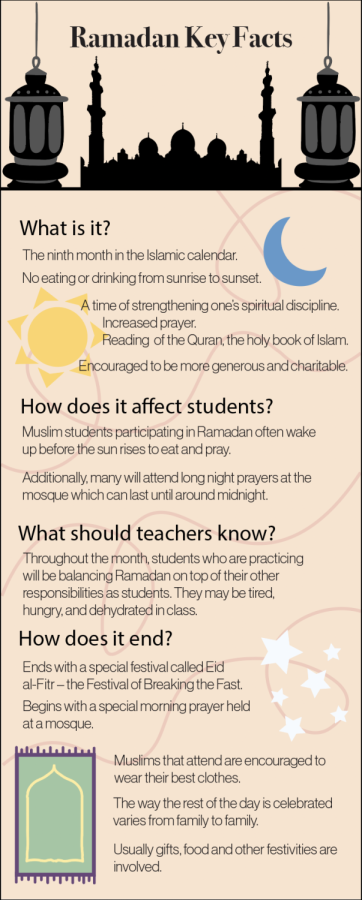
On March 31st, 2023, after many years of advocacy by the Arab American community, President Joe Biden issued a proclamation designating April as National Arab American Heritage Month. Federal recognition of the contributions of Arab Americans is noteworthy, because, “the Arab American story is the American story”, one that includes diverse backgrounds and faiths and rich traditions and culture. This month we encourage you to recognize and celebrate the achievements and contributions of Arab Americans in shaping the social fabric of the United States.
Check out the resources below for more information on how to celebrate Arab American Heritage Month:
Arab American Heritage Foundation:
“The Arab America Foundation (AAF) is a non-profit educational and cultural organization, who advocated for recognition of National Arab American Heritage Month (NAAHM). AAF’s mission is to promote Arab heritage, educate Americans about the Arab identity, and to empower and connect Arab Americans with each other and with diverse organizations across the US. Learn more about Arab culture and presence in the US on the AAF website and be sure to check out their Educator Resources and NAAHM Curriculum Kit.
Arab American National Museum:
Take a look at the Arab American National Museum to learn more about the history and culture of the Arab American experience. Their education content includes virtual galleries and exhibits, as well as educational content and lesson plans for educators.
Arab American recognition:
This article looks over the history of Arab American Heritage month and the path to national recognition.
How to celebrate:
Looking for ways to teach and celebrate Arab American Heritage month? This article outlines different ways to immerse yourself in Arab culture through books, art, movies, history, and advocacy. Here is another resource that provides a brief overview of Arab American Heritage month along with more resources to learn about Arab culture in the US. Last but not least, this presentation uses various books that showcase the Arab American experience.
Engaging Heritage Learners in the Arabic Classroom:
This Arabic Teacher’s Council workshop from Fatima Khaled of the Peace School in North London discusses what it means to be a heritage learner and how teachers can engage these students in the classroom through art and digital storytelling.
Invite an Expert to speak about the Arab American Experience:
William Lafi Youmans is an Associate Professor at the School of Media and Public Affairs at George Washington University and teaches about global communication, media industries, and Arab American studies. Invite him to speak with your classes about the Arab American experience through the “Zoom in on the Middle East” Virtual Speakers Bureau.
March 20th, 2023 marks the 20th anniversary of the 2003 US invasion of Iraq, perhaps the most divisive and controversial US conflict since Vietnam. The war’s legacies in the Middle East include heightened violence and the proliferation of extremist groups like ISIS. In the US, these impacts include a decline of public trust in the government, media, and other institutions as well as a rise in violence and discrimination against Muslims and Arabs.
Islamophobia, or the fear, hatred, and prejudice against Islam and Muslims increased in parallel with negative stereotypes of Muslims in the media and a perception that Islam and terrorism were intrinsically linked. These assumptions are rooted in a concept known as Orientalism, a framework that promotes an image of the Middle East and its people as primitive, irrational, and inferior. For more information and teaching resources on Orientalism and Islamophobia, check out our IMES Resource guide on Orientalism and Islamophobia.
Other IMES teaching resources for talking about the war in Iraq and its legacies include:
- IMES film library guide gives synopses of films in our lending library. Some of the available films that showcase the Iraqi experience include: About Baghdad, The Dreams of Sparrows, Iraq in Fragments, The Surge: the Untold Story, No End in Sight: Iraq’s Descent into Chaos, My Country My Country, and Turtles Can Fly.
- Veteran Workshop Lesson Plan offers a lesson plan that looks critically at the way different textbooks teach and describe the war in Iraq and the “War on Terrorism” and the media portrayal of both events.
- GWU Professor Melani McAlister is a cultural historian who has written extensively about the U.S. Image of the Middle East and the interaction of culture and foreign policy. Invite Prof. McAlister to speak to your classes about how the war in Iraq shaped U.S. culture and media through the IMES Middle East Virtual Speakers Bureau.
To further reflect on the impact of the war, join IMES and the Quincy Institute, virtually or in-person, on March 22, 2023 for Bad News: How the Media Marched Us to War in Iraq and Beyond, a roundtable discussion on the role of the media in the Iraq war and its legacy with speakers Peter Beinart, Kelley Beaucar Vlahos, Jonathan Landay, and Krystal Ball.
